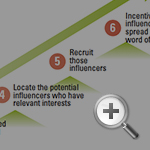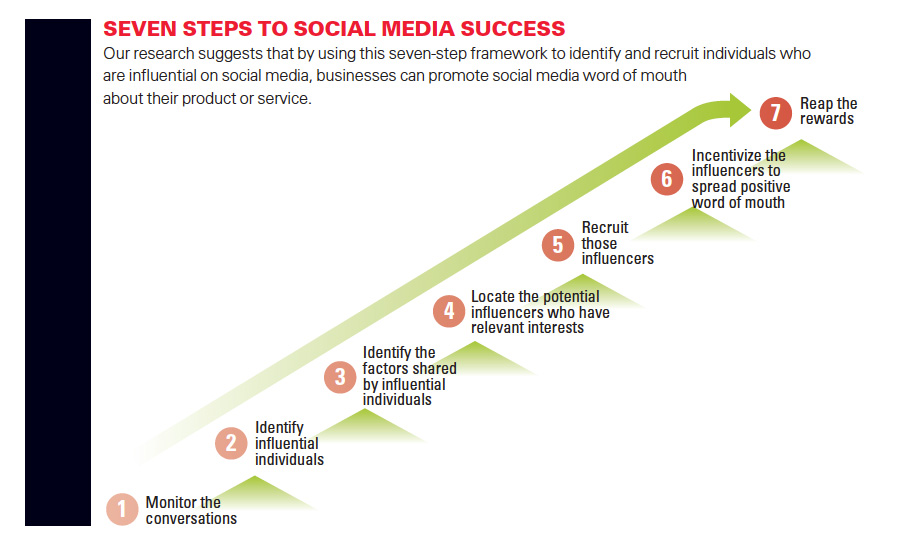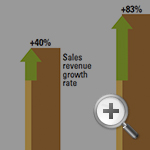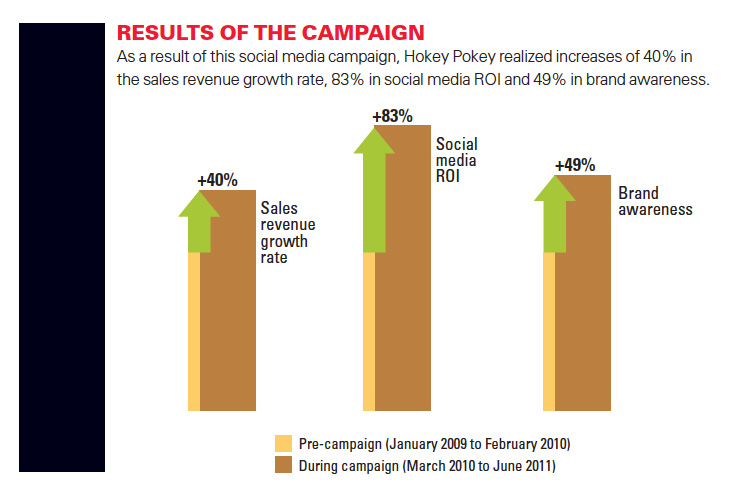Increasing the ROI of Social Media Marketing
By following a seven-step process to identify and recruit potential brand ambassadors in online social networks, an ice cream retailer substantially improved the effectiveness of its social media marketing.
Topics
Social Business

Ice-cream retailer Hokey Pokey encouraged influential social media users to tweet about their custom ice-cream creations.
Image courtesy of Hokey Pokey.
Now that so many people worldwide participate in online social networks — 955 million on Facebook alone1 — influencing consumer preferences and purchase decisions through these networks and word of mouth (WOM) is an increasingly important part of every marketer’s job. Many enterprises are investing in social channels to rapidly create or propagate their brand through viral content, social media contests and other consumer engagement efforts. Their traditional campaigns are changing, too. Companies such as Geico, Dell and eBay are adapting the traditional “one-way” advertising message and using it as a stepping-stone to begin a two-way dialogue with consumers via social media.2
Marketers know that theoretically, social media should be a powerful way to generate sustainable, positive WOM. If they can only select the right social media platform, design the right message and engage the right users to spread that message, their campaign should be a success. But until now, that’s been a big if.
Creating Successful Social Media Campaigns
An effective social media strategy should clearly define the marketing objectives, evaluate the opportunities and select an appropriate form of social media to communicate. Today’s social networking sites are also equipping themselves with analytical capabilities to analyze the reach, spread and impact of a social media message. In light of these goals and tools, we developed a seven-step approach to ensure a successful social media campaign. (See “Seven Steps to Social Media.”)
The Leading Question
How can a company improve the ROI of its social media campaigns?
Findings
- Identify social media users who are both influential and particularly interested in the company’s product or service category.
- Incentivize those influencers to talk about the company’s product or service.
- Use metrics to calculate the value of an individual’s influence.
Our research suggests that by developing and implementing this seven-step method to first identify the net influence wielded by a user in a social network and then to predict that user’s ability to generate the viral spread of information, businesses can identify the “right” individuals to engage in social media conversations to promote WOM. Further, we found that by linking the generated WOM to actual sales, social media can be used to induce positive WOM, spread brand knowledge, generate sales and increase return on investment.
A Seven-Step Framework for Social Media Marketing
Step 1: Monitor the conversations. By monitoring brand-related conversations that are happening in the social media platforms, businesses can gain access to valuable information, influential people and relevant conversations that already show engagement with the brand.
Step 2: Identify influential individuals who can spread messages. Companies can use the data to identify a pool of influential individuals (we refer to them as “influencers”), some of whom might be induced to spread the “right” message, from the company’s perspective.
Step 3: Identify the factors shared by influential individuals. Next, companies should find commonalities among the candidates and create profiles of typical influencers. Creating such profiles prepares businesses subsequently to locate all the influencers relevant to their campaign and design ways to encourage those influencers to talk about the company’s products or services. Previous researchers3 have found that influencers on social media exhibit high levels of engagement in three aspects: (1) message spread (the number of times a message is forwarded, with or without modification, by the receivers); (2) influence (the number of times the message is forwarded by recipients to their friends); and (3) social impact (the number of comments and replies received for each message). We developed a metric to capture these three aspects, which we call our Customer Influence Effect (CIE) metric. (See “Calculating the Effect and Value of Social Media Influence.”)
Step 4: Locate those potential influencers who have interests relevant to the campaign. To find potential influencers for a particular social media campaign, it is not enough to identify social media users with influence; instead, a company needs to identify those influential social media users who are particularly interested in the company’s category of goods and services. To do this, we developed a metric we call the Stickiness Index (SI), which measures the degree of WOM generated by a particular user on a given topic — essentially, how much of a user’s discussions via social media are about a particular topic. This metric can help businesses locate the individuals who not only have influence but also like to talk about a particular product category. (See “Calculating the Effect and Value of Social Media Influence.”)
By identifying influential individuals who are especially interested in their product categories, marketers can go beyond simply “listening” to conversations on social media platforms and actively identify potential brand ambassadors.
Step 5: Recruit those influencers with interests relevant to the campaign to talk about the company’s product or service. Once a company has identified influential users who are particularly interested in the company’s product or service category, the next step is to enlist those influencers in the company’s social media campaign or campaigns to spread positive WOM. This can be achieved by developing interactive online content and designing ways in which influencers can promote positive WOM that can be tracked and measured, such as through online games.
Step 6: Incentivize those influencers to spread positive WOM about the product or service. By incentivizing influencers to create buzz about their products or services in a social media campaign, businesses can both retain customers and attract prospects. The incentives offered to influencers can be tangible (such as discounts or freebies), intangible (such as recognition in a social network) or both.
Step 7: Reap the rewards from increasingly effective social media campaigns. By taking the above steps, businesses can more accurately measure the performance of their social media campaigns. By monitoring and tracking positive WOM and linking it to product and brand growth, businesses can develop more effective social media campaigns — and should, as a result, start to see enhanced financial performance, more customer engagement and increased brand awareness.
Implementing the Seven Steps at Hokey Pokey
Hokey Pokey Ice Cream Creations is an upscale ice-cream retailer with more than a dozen outlets across India, offering a unique selection of super-premium ice-cream. Three years ago, Hokey Pokey executives, realizing that most of their consumers were active social media users, decided they needed to engage their customers in social media through a profitable media strategy. Working within a limited marketing budget, the retailer wanted to create positive buzz about Hokey Pokey and acquire and retain profitable customers, while ensuring a high ROI. To help Hokey Pokey with this issue, we implemented the seven-step approach over a 30-month period. (See “About the Research.”)
For the first step — monitoring the conversations — we spent six months understanding the local social media market in the city where Hokey Pokey has the most outlets and its potential for generating and influencing purchase decisions. We monitored 825,091 conversations involving 1,736 individuals across various social networking sites.
In the second step, we identified the kind of influential individuals in the local social media market who might spread Hokey Pokey’s message, based on three parameters: (1) the number of times an individual’s messages were forwarded (or modified, then forwarded) by recipients ; (2) the number of connections that those messages jumped (for example, if a message from one individual was received by a second individual and then forwarded to a third individual, we considered the message to have jumped two connections); and (3) the number of comments and replies the users received for each message. Based on these characteristics and the ease of data collection, we zeroed in on Facebook and Twitter as suitable platforms for this study.
In the third step, we identified four ideal, generalizable characteristics of key influencers:
1. Activeness, which we defined as the number of times the influencer and his or her network of friends “see” and “share” a message.
2. Clout, which we defined as the number of connections and followers an influencer has.
3. Talkativeness of the receiver, which we defined as how often the influencer’s message is being “retweeted,” “hashtagged” or shared.
4. Likemindedness, which we defined as similarities and common interests shared by the influencer and his or her network friends.
These ideal characteristics matched well with Hokey Pokey’s objectives in this study, which were to create and spread its brand identity, to stimulate and encourage a strong brand association among consumers and proactively identify brand advocates, and to reach potential customers through existing customers. These factors helped us compute the CIE metric that we created. (See “Calculating the Effect and Value of Social Media Influence.”)
In the fourth step — locating the potential influencers with interests relevant to the campaign — we helped Hokey Pokey move beyond simply monitoring conversations on social media platforms and begin to actively engage in the identification of brand ambassadors. While the CIE metric enabled Hokey Pokey to identify individuals exhibiting the ideal characteristics to be influential on the social networks, we wanted to make sure these individuals also liked to talk about ice cream. They needed to have not only a high CIE but a higher-than-average share of WOM about ice cream in social media. Toward this end, we developed the SI metric. (See “Calculating the Effect and Value of Social Media Influence.”) The SI metric helped us identify the number of individuals in the region who actively discussed ice cream on social media.
In the fifth step, we recruited those influencers who were already engaged in social media discussions related to the category to participate in a campaign designed to promote Hokey Pokey ice cream. This campaign helped us to track and measure the positive WOM of Hokey Pokey’s offerings.
For the sixth step, we implemented the campaign in two stages: “Creations on the Wall” and “Share Your Brownies.” These two stages of the campaign encouraged the influencers recruited for the campaign to make custom ice-cream creations at any of the Hokey Pokey parlors, identify themselves with their creations and spread WOM about their creations via the social media platforms. In the “Creations on the Wall” phase of the campaign, Hokey Pokey marketers trained the parlor employees to educate influencers about custom creations and distribute a form into which influencers could enter the recipes for their creations. Influencers could name their creations, identify themselves with their creations and post their recipes on a wall in the parlor dedicated to the purpose. Customers walking into the parlor could browse this wall and purchase these creations or order from the regular menu.
The second, “Share Your Brownies” phase of the campaign was aimed at generating a viral spread of the ice-cream creations by nurturing a sense of personal identity. In this part of the campaign, the influencers from “Creations on the Wall” were motivated to tweet about their creations to compete for both tangible incentives (such as customized T-shirts) and intangible ones (such as a chance to enhance their peer standing by sharing their creations on Facebook and Twitter). Each creation was shared with all the parlors of Hokey Pokey, which increased the buzz about the campaign. We tracked all relevant social media discussions during four time points in the study (May 2010, September 2010, January 2011 and June 2011), and Hokey Pokey incentivized influencers by giving them “Brownie Points” when their followers or friends made a purchase or discussed their ice-cream creations online. These points were redeemable for prizes and product discounts.
Our tracking revealed some interesting business trends for Hokey Pokey. For instance, the “Sahara Surprise” flavor was only mildly popular during the initial phases of the campaign and was seldom discussed between March and September of 2010, but it became one of the most discussed creations after influencing a few high-CIE users around November of 2010. We continuously recalculated the CIE metric and used it to identify sets of consumers who evangelized their own creations at different points in time and kept the buzz alive.
In the final step, we measured the results of the social media campaign by relating the abstract social media measures such as “comments” and “conversations” to the financial metrics in order to demonstrate the increase in buzz and monetary gains. We accomplished this by using the Customer Influence Value (CIV) metric that calculates the influence of an individual’s WOM on future sales. (See “Calculating the Effect and Value of Social Media Influence.”)
The implementation of the above phases enabled us to identify the influencers using the CIE (intangible contributions) and CIV (tangible contributions) metrics for Hokey Pokey’s customers.
The Campaign Results and Implications
This campaign had effects at both the company and the customer level. At the company level, the main impact was in the area of social media accountability. While most companies are still grappling with social media accountability, the use of the CIE and CIV metrics gave Hokey Pokey an important competitive edge. At the customer level, being able to calculate the value of an individual’s influence in a network and measure the monetary value of customer influences made it possible for Hokey Pokey marketers to greatly enhance the efficacy of their social media campaign. In evaluating the performance of the framework, we benchmarked Hokey Pokey’s revenue (based on ice-cream sales) generated through Facebook and Twitter against the previous three years’ performance metrics, including sales growth rate, ROI, number of positive and negative conversations, and number of repeat visits. We found that out of the total revenue generated from the “Share Your Brownies” campaign, about 23% was attributable to conversations on Twitter and about 80% was attributable to Facebook, with a 3% to 8% overlap between the two social networks. Overall, the campaign was a huge success: Hokey Pokey realized increases of 49% in brand awareness, 83% in ROI and 40% in the sales revenue growth rate. (See “Results of the Campaign.”)
Our study described the application of our seven-step approach to social media analysis in a localized setting for a small business chain, but it could be directly extended to a larger global enterprise. Companies such as Dell and Zappos already have strong customer relationship management and ticketing systems tied to social networks, which should make measuring the impact of influence at the point of sale relatively straightforward for them. This study focused on a brick-and-mortar retailer, but the same methodology should work even better online. For instance, online retailers could allow their customers to sign in at their sites with their social network IDs from Twitter, Facebook, Google+, etc. and directly tie online customer influence to sales.
However, changes in social network privacy policies may make collecting this data increasingly challenging. The privacy rules at Facebook and Twitter, for example, have grown more stringent since we collected the data for this study; at that time, it was easier to track influencers’ conversations. Analysts may now have to find new ways to gather this type of data, such as encouraging users to give them permission to follow the relevant communications or even creating company-sponsored forums to help people share their messages. However, our three metrics should still function despite these restrictions.
The seven-step approach described here, along with the CIE and CIV metrics, solves an important problem for social media marketers: identifying influencers. Despite the vast amount of individual and relationship data available through these media, most organizations have been unable to directly and efficiently measure the effectiveness of their social media strategy. The lack of robust methodologies to measure the impact of social media efforts is addressed in this study. It provides tangible metrics and a robust methodology to measure the effectiveness of social media marketing spending and to maximize the ROI of social media campaigns.
References
1. Facebook.com statistics on the number of active users at the end of June 2012.
2. P. Kotler and G. Armstrong, “Principles of Marketing” 12th ed. (Upper Saddle River, New Jersey: Prentice Hall, 2007): 481.
3. P.V. Marsden and N.E. Friedkin, “Network Studies of Social Influence,” in “Advances in Social Network Analysis: Research in the Social and Behavioral Sciences,” eds. S. Wasserman and J. Galaskiewicz (Thousand Oaks, California: SAGE Publications, 1994); and D.J. Watts and P.S. Dodds, “Influentials, Networks, and Public Opinion Formation,” Journal of Consumer Research 34, no. 4 (December 2007): 441-458.
i. V. Kumar, V. Bhaskaran, R. Mirchandani and M. Shah, “Creating a Measurable Social Media Marketing Strategy for Hokey Pokey: Increasing the Value and ROI of Intangibles & Tangibles,” Marketing Science, in press.
ii. For more details, see C.H. Hubbell, “An Input-Output Approach to Clique Identification,” Sociometry 28 (1965): 377-399.
iii. Kumar et al., “Creating a Measurable Social Media Marketing Strategy for Hokey Pokey.”






Comments (3)
L’exemple d’Hokey Pokey.
Aziz Memon
jevedebe